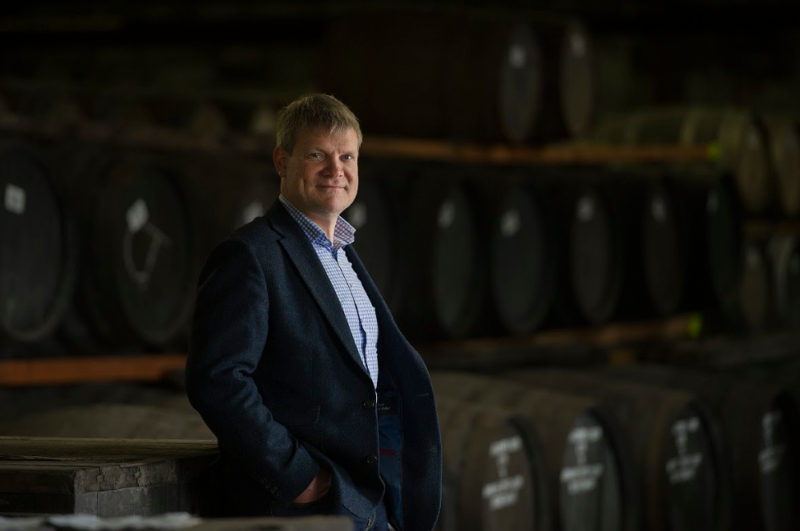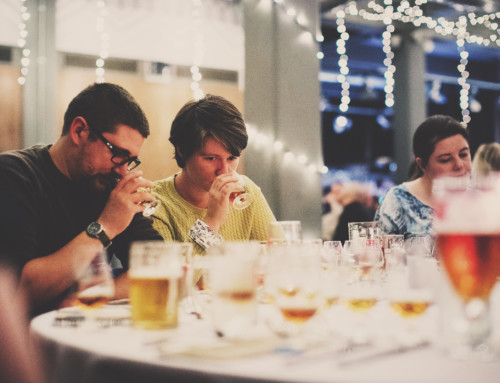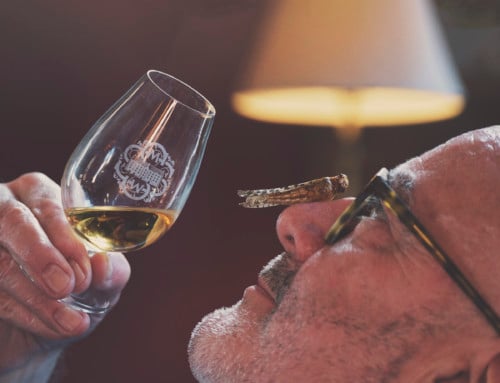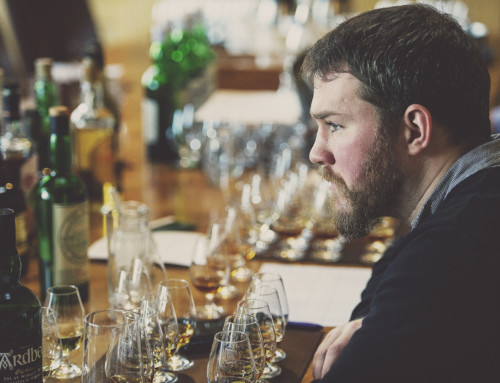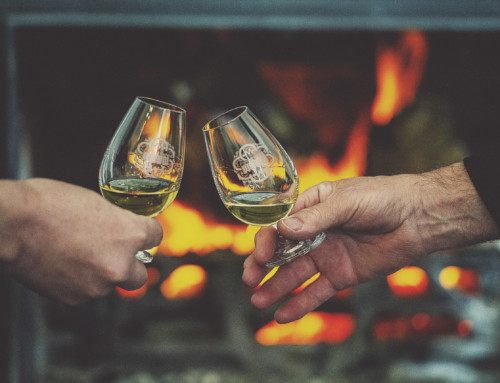Cask purchasing, coronavirus, Tasting Panels and sampling whisky infused with sheep dung – The Scotch Malt Whisky Society’s spirits director Kai Ivalo tackles a variety of questions in his question and answer session with Society UK ambassador Monique ten Kortenaar.
WHAT’S YOUR ROLE WITHIN THE SMWS?
I’m both the spirits director and the marketing director. I work with the two teams for both sides of the Society. I started working on the spirits side in 2009 and it includes everything from the planning, buying casks, wood policy, maturation, warehousing and selection for bottling. I work closely with [spirits manager] Euan [Campbell] for that.
WHAT’S YOUR BACKGROUND?
I’ve been with the Society since 2004, so around 16 years now. Before that I worked in advertising agencies, and one of my clients was The Macallan. An interesting connection is that when I was in that agency and we were pitching to win that account, we did all our preparation in the tasting room at The Vaults. But I’m a long-term malt whisky enthusiast, I got into malt whisky during my student days in Aberdeen in the mid to late 80s, so I guess it was a long time coming.

WHAT DOES YOUR AVERAGE WORKING DAY LOOK LIKE?
One of the things I like the most is the fact that there is no real average. The days are very different. At the moment a little bit too much, because of the challenges we’re having to deal with! We’re a relatively small organisation still, so lots of people get involved and one of the things I like about that is that there is room for everybody to come up with ideas. A lot of what I do is future planning, rather than what’s happening at the moment, so that might be looking at stock purchases for the future, or discussing future releases with Euan, that kind of thing. To give you an interesting variation on that, this morning I spent two hours on a Zoom call with the Scotch Whisky Research Institute (SWRI) as part of their flavour and sensory team, looking at some of the latest updates in research and planning there, so it’s a lot of different things every day.
ARE THERE CERTAIN REQUIREMENTS FOR A DISTILLERY TO BE ADMITTED TO THE SOCIETY?
Firstly, the quality of the spirit is the main thing, and in recent years there have been a lot of newer distilleries that don’t have a track record or finished products, so we ask a lot of questions to find out what people are doing, we want to sample new-make spirit if that’s where they are. It’s about understanding the quality and reputation involved to start with. One of the things that’s increasingly important to us as well is sustainability of supply. It’s really nice to get maybe get a cask or two from an interesting distillery but what we’d rather have is the knowledge that there are going to be several casks coming through the pipeline in the future so that members have that to look forward to. It’s always disappointing if there are only one or two casks that are available and not much more than that. We also look at things like the likely level of member interest, so if it’s an obscure distillery from a less well-known country, if I can put it that way, we have to be sure that there will be enough interest and demand from members. And obviously pricing is an issue as well, we’re dealing with stock of everything from zero to 30 or 40 years old as well.

THE TASTING PANEL SWITCHED FROM BEING IN THE SAME ROOM TO DOING THE TASTINGS ONLINE BECAUSE OF CORONAVIRUS. THIS COULD POTENTIALLY BE REPEATED BY ADDING MEMBERS FROM OTHER COUNTRIES – WOULD THAT MAKE SENSE?
Technically it’s possible. It’s a point that came up in this morning’s discussions with SWRI, because obviously many of the big whisky companies there have got challenges with their own sensory and tasting panels as well. I guess the start point for us is we have an evaluation process for any panellists, they have to go through a sensory evaluation and meet a score so that we can tell that their nose is wired up to their brain. Then on top of that we are looking at more monitoring of panellists, just to make sure that everybody is on top of their game. We all have our strengths and weaknesses in terms of our sensory abilities, so it might be about helping you to learn which aromas you need to study more, or it might be a case of recognising that when you put a panel together you don’t have people who are too similar in terms of their ability. Those are all parts of the jigsaw and I guess where we are at the moment is a temporary measure – it’s not what we planned, and while it works it’s going to be a lot easier if we can get everybody back in the same room at some point in the future. It’s also a lot of administration to get smaller sample bottles sent out to people. But it is something we can potentially do for certain projects in the future. Like everything else, we’ve learnt a lot of interesting lessons over the past few weeks as to what we can and can’t do.
HOW MANY PEOPLE ARE THERE ON A PANEL?
We have a total number of around 20 panellists who we can call up at any time, but when the Panel sits, typically you’re looking at three or maybe four people at one time in a session. That’s quite different from where we used to be, and if I think back 10 or 15 years ago there might be occasions where we would have eight people sitting in a Tasting Panel. I had a few occasions in those days where I might have been the chair of the Panel and trying to capture all of the important flavours, and teasing out and making sure everybody was contributing was really difficult then. Now it’s much easier, we have an online system to capture it and we have more confidence in the people who are on the Panel as well.
WHAT IS THE WEIRDEST OR STRANGEST WHISKY YOU EVER CAME ACROSS AND WHY?
I was in Seattle in February at an event called the World Whisky Forum, lots of craft and small distillers were there including an interesting distillery from Iceland. They picked up the very old Icelandic tradition of smoking using sheep dung, so yes, I’ve tried a whisky that basically has sheep dung as one of the elements. That was interesting!
WAS IT NICE?
It was…herbal and earthy!
YOU’VE SAID ENOUGH! THE SOCIETY HAS STARTED THE ‘HERESY’ SERIES OF BLENDED MALTS. WHICH BLENDED MALT WOULD YOU LIKE TO MAKE SOME DAY AND WHY?

The idea for that Heresy series goes back to 2011. We were owned by Glenmorangie in those days, it was an idea that we put forward at that stage and unfortunately with the set up there it wasn’t possible for us to be able to execute, so the idea remained with us until 2015 when we became an independent company again. And we were really pleased to be able to pick that one up. As you may know the first release was Exotic Cargo – a big sherried blended malt. We’re fortunate to have lots of ideas, we call it the ‘experimental series’ because it’s always about doing something different, and something new and moving to forward. For me, to answer your question, what I’m really interested in at the moment is the toasting of casks, so heavily toasted flavours. If you’ve tried any of our STR (shaved toasted recharred) single casks, or HTMC (heavy toast medium char) casks, there are really rich flavours in there, and that’s something I’m keen to take forward. Or maybe French oak, with additional maturation as well, in fact we’ve got something that’s done a bit of that, layered with some other casks as well, which it still a work in progress. I’m keen to ask members what they’d like to see from us in terms of either a flavour profile style, or a collaboration. We did a beer collaboration with ‘Old Fashioned’, along with Tempest Brewery which is my local brewery a few miles down the road, and it might be there are other collaborations that members think might be interesting for us to do, so if you have any suggestions, do let us know and fire them over.
YOU WENT TO SEATTLE IN FEBRUARY, AND YOU’VE BEEN TRAVELLING ELSEWHERE IN THE US. TELL US A BIT ABOUT YOUR ADVENTURES THERE? DID YOU COME TO SOME INTERESTING DEVELOPMENTS FOR BOTTLINGS THAT ARE COMING OUT?

Yes, I’ve done four trips to the US in the last 18 months or so, and it’s fascinating – it’s obviously a huge country, it has its own whiskey and distilling tradition and they are doing lots of interesting things. I’ve been along with some of our colleagues from the US branch of the Society. I’ve been to New York state, Washington, Virginia, Texas, Illinois, Kentucky. The big trip last year with Euan was to Kentucky. We started off I suppose with more of an interest in American single malts and seeing how that’s going. It’s a brand-new category, it’s not even officially recognised by the authorities in the States, so it’s a really exciting time to see what’s happening there and how they’re interpreting it. For me it’s always interesting to see how different countries take the concept of single malt and develop it and make it their own, rather than trying to pretend to be Scotch or something like that. But then we’ve also been looking at bourbon and rye, these are thing the Society has bottled in previous years. What’s been great is that we’ve had some good meetings. Part of it was about learning and getting information, content, making connections, because like in Scotland it’s a very people-based business and you only really get to trade with people once they get to know you.
We’ve got some casks being bottled in the States, we’re not bottling in the UK, partly because of the tariff situation with the EU and the US in whiskey, so it’s easier to get them bottled there, and also because it makes it more sustainable going forward. Members should hopefully start to see some of those single cask bottlings coming through in the back half of this year. We had hoped that we might be able to get some more through, but our plans are going to be affected by the current coronavirus situation. But it’s a long-term strategy and plan for us in the future.
YOU ALREADY WENT TO JEREZ, ANYTHING INTERESTING THERE OR CAN YOU TELL US MORE ABOUT YOUR EXPERIENCES THERE?
That’s equally fascinating but in a very different way and sherried whisky obviously has a massive following and is very interesting for us. It’s a key part of our future offering for members, so we need to make sure that we are knowledgeable of the variety of offerings and producers, cooperages, bodegas that are available out there. For us it’s been about building a network of cask suppliers to help us deliver variety, which is at the core of what we do, to learn more about sherry casks, the different variations and also gather information and content that we’ll use to give to our members in term of videos and stories and information.

For me what’s been most interesting thing is in the sheer variety of what’s available and the different things you can do. If you think about it you start with the wood type, American oak, European or Spanish oak. What treatment do you want to do to the wood in terms of toasting regimes? The wine you put in there (for us it’s mostly oloroso and Pedro Ximenez, the oxidised style of sherry)? The wine seasoning period –it is one year or three years, or are we buying a bodega solera system? So there is an awful lot of variety and options for us.
AS THE SCOTCH MALT WHISKY SOCIETY SPIRITS DIRECTOR, WHAT CAN YOU TELL US ABOUT CHANGES IN THE SPIRITS INDUSTRY?
There’s always a lot going on. From my point of view there are probably about three or four things that are of interest now. The first one is the fact that the Scotch whisky industry is really starting to pay more attention at the moment to barley varieties and yeast. For a lot of companies the yield or efficiency has been one of the main drivers when it comes to selecting barley and yeast for production, but there is now more interest in looking at different barley varieties, such as heritage varieties. What kind of flavours do they offer, what are the implications on efficiency? Then there are custom yeast options. Andy Forrester, our spirits educator, calls yeast ‘flavour factories’, a lot of focus is going into that side now and I think we’re going to have a lot of fascinating new-make spirit styles coming through, maybe even going back to some of the styles of the past. So that’s one.
Another is in the application of alternative maturation techniques. One of the things that’s been interesting about travelling and seeing what people are doing for example has been in America or France and seeing how they look at things differently. I’m slightly haunted by a piece of feedback I got from a distiller in Armagnac who said: ‘You guys in Scotch are lazy – you fill a cask up , put it in a warehouse and leave it.’ I said what do you mean? He said we’re constantly doing things each year, we’ll aerate the spirit, we’ll gradually reduce it – there were all these different techniques they do. In Cognac it might be their approach to ‘elevage’, in the US it might be things like lower filling strengths to achieve a more mature younger whisky. These are things that are fascinating in terms of how they might be applied to Scotch, how they could work and obviously where they are permissible within the Scotch Whisky regulations.
I guess the final one is really the cohort of new small distilleries that have come out over the past few years, they have all been developed in that recent period and they are all going to come on sale roughly at the same time. So how are they going to compete with the existing brands, what are they going to do to stand out and be different, can they all make a finished product? I think that’s going to be an interesting development to see over the next few years as well.
LAST QUESTION…HOW WILL THE IMPACT OF CORONAVIRUS AFFECT THE WHISKY INDUSTRY’S FUTURE?
I guess the short answer I’m afraid is that we don’t yet know. It’s an evolving picture. But where we are at the moment is that the Society is in good shape in terms of stock, we have plenty of whisky laid down to carry us over,
And one year out of several years of production isn’t really going to be a problem for us when we’re planning out in terms of 25 or 30 years in terms of our stock model. But some distilleries have closed down for a period so there will be less of their stock in the marketplace, that may or may not affect us. I think the thing to hold on to is that it’s pretty clear at the moment that demand for single malt Scotch whisky has held strong, retail sales are good, and consumers and enthusiasts are interested so from that point of view the major producers are optimistic and will be taking a long-term view in terms of production and getting back to whatever the new normal will be.
The smaller distillers may be a different story. I don’t yet know what the story is here in Scotland as to how badly it may be affecting some people, however, I have heard from the States that there are some fairly scary stories about how many craft distilleries are expected to get into really serious trouble in the current situation, so we’re yet to see how that comes out.
There could be some opportunities that occur out of it. The Society was formed in 1983 and there are some historical elements in there, with distilleries closing at the time and the much-fabled whisky lochs of excess supply, so there could well be some opportunities to come across stock that we otherwise wouldn’t be able to get hold of. One of the things that Euan and I will be doing is trying to sound out some of those opportunities. As I said, it’s too early to tell, we don’t really know, but I’m going to be optimistic in my view in terms of how this will go. Scotch whisky is a long-term game.



